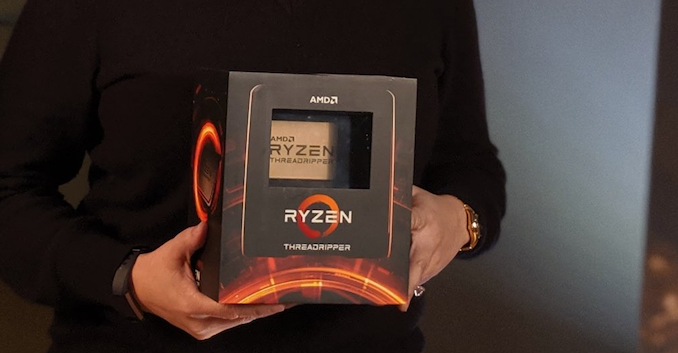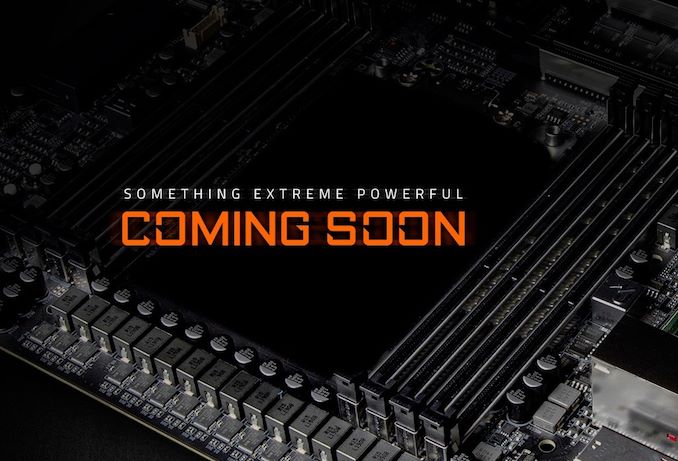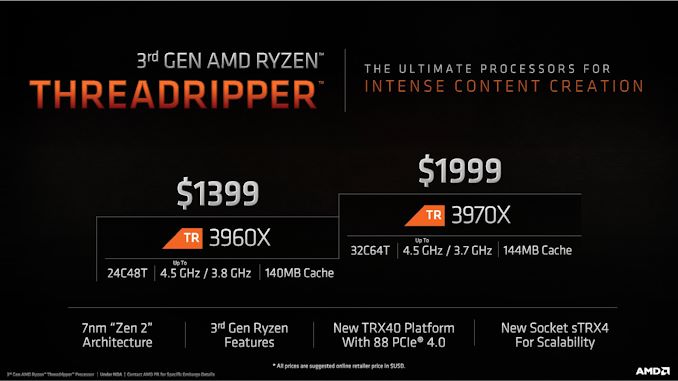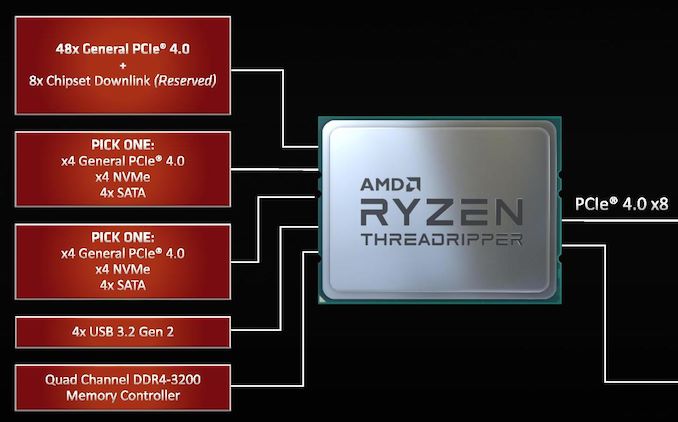AMD Q4: 16-core Ryzen 9 3950X, Threadripper Up To 32-Core 3970X, Coming November 25th
by Dr. Ian Cutress on November 7, 2019 9:00 AM EST3rd Gen Ryzen Threadripper, Up to 32-Cores
It’s the product a lot of users have been waiting for. Ever since AMD introduced the world to its Rome processors, with up to 64 cores based on 7nm chiplets and the Zen 2 microarchitecture, rumors have been swirling about what exactly the corresponding Threadripper platform will bring. We now have the answers to your questions.

From CEO Dr. Lisa Su's Twitter
The two processors that AMD will be initially launching in the 3rd Generation Ryzen Threadripper family are the TR 3960X and the TR 3970X. These are 24-core and 32-core parts respectively, built using four chiplets and one IO die in a Rome-sized package. Both CPUs will feature a 280 W TDP, and offer boost frequencies up to 4.5 GHz.
| AMD HEDT SKUs | |||||||
| Cores/ Threads |
Base/ Turbo |
L3 | DRAM 1DPC |
PCIe | TDP | SRP | |
| Third Generation Threadripper | |||||||
| TR 3970X | 32 / 64 | 3.7 / 4.5 | 128 MB | 4x3200 | 64 | 280 W | $1999 |
| TR 3960X | 24 / 48 | 3.8 / 4.5 | 128 MB | 4x3200 | 64 | 280 W | $1399 |
| Second Generation Threadripper | |||||||
| TR 2990WX | 32 / 64 | 3.0 / 4.2 | 64 MB | 4x2933 | 64 | 250 W | $1799 |
| TR 2970WX | 24 / 48 | 3.0 / 4.2 | 64 MB | 4x2933 | 64 | 250 W | $1299 |
| TR 2950X | 16 / 32 | 3.5 / 4.4 | 32 MB | 4x2933 | 64 | 180 W | $899 |
| TR 2920X | 12 / 24 | 3.5 / 4.3 | 32 MB | 4x2933 | 64 | 180 W | $649 |
| Ryzen 9 3950X | 16 / 32 | 3.5 / 4.7 | 32 MB | 2x3200 | 24 | 105 W | $749 |
There’s a lot to unpack here.
The 32-core TR 3970X has 64 threads, a base frequency of 3.7 GHz, a turbo frequency of 4.5 GHz, comes with 64 PCIe 4.0 lanes, four memory channels of DDR4-3200 (1DPC), and will retail at $2000. To put that in perspective, it wasn’t too long ago that for that money you would only get 10 cores.
The 24-core TR 3960X offers almost the same, but trades a few cores for a 3.8 GHz base frequency and will retail for $1399. The competition for this part is likely to be the Core i9-10980XE, which has 18-cores and has a tray price of $979.
Both CPUs have 128 MB of L3 cache, due to the use of four chiplets. We asked AMD if these CPUs have 4 chiplets inside the package and 4 dummy ones, like the dummy silicon in previous Threadripper products – AMD confirmed that there will only be four chiplets in each package. This means that each CPU will be in a symmetrical 6+6+6+6 or 8+8+8+8 configuration, minimizing the total amount of silicon AMD has to ship.
Each CPU supports four channels of DDR4-3200. We confirmed that this included support for ECC UDIMMs on a board-by-board basis, but does not include RDIMM or LRDIMM support. AMD did state that these new CPUs are validated for the 32 GB DDR4 modules coming onto the market, which makes a realistic maximum DRAM support of 256GB (8 x 32GB).
For performance, AMD gave us some numbers comparing each CPU to the 18-core Core i9-9980XE from Intel. In common workstation tasks, such as program compilation, Adobe Premier transcoding, and rendering, AMD is quoting a +22-31% performance gain for the 24-core part, and a +36-49% uplift for the 32-core part.
When we asked AMD about AI performance, they stated that while AI is an emerging workload in the enterprise space, for the workstation market these products are targeting exactly what their customers are requesting today: ‘Threadripper and Zen 2 have been taken by customers looking at content creation, CAD, and code work/compilation. AI is still an emerging vertical in the workstation at this time.’
Compared to previous generation Threadripper parts, the new 3rd Gen Ryzen Threadripper features a central I/O die in the hardware which all the chiplets are connected to. This I/O die has all the PCIe lanes and the DRAM channels, which means that the memory latency issues with the 1st/2nd Generation Threadripper should no longer be present with the new chips. Both chips launched here have 64 PCIe 4.0 lanes, which are split into 48x general purpose lanes, 8 lanes for the CPU-to-chipset communications, and 8 lanes for I/O. This means that users can have the following CPU configurations:
- 1st root complex: x16 or x8/x8
- 2nd root complex: x16 or x8/x8
- 3rd root complex: x16 or x8/x8
- Chipset downlink: x8
- Pick one: PCIe 4.0 x4 slot, 1 x NVMe PCIe 4.0 x4, 4x SATA
- Pick one: PCIe 4.0 x4 slot, 1 x NVMe PCIe 4.0 x4, 4x SATA
Obviously things like SATA ports can also come off the chipset. We discuss the new chipset on the next page. But one thing to note here is the CPU-to-chipset connection.
For AMD Ryzen on most AM4 chipsets, for first generation and second generation Threadripper, and for every Intel platform in recent memory, the connection between the CPU and the chipset has been the equivalent of a PCIe 3.0 x4 link. This link, as the industry has progressed into the world of NVMe storage, has become a bottleneck for any user wishing to push a modern PCIe-based storage drive along with anything else on the same uplink. AMD increased it for the X570 motherboard generation to PCIe 4.0 x4 for mainstream, doubling the bandwidth from its closest competitor, but what AMD is doing with the new 3rd Gen Threadripper is increasing that link bandwidth by a factor of two again.
With this CPU, and the TRX40 chipset, users now have a PCIe 4.0 x8 link between the CPU and the chipset. This is the equivalent of a PCIe 3.0 x16 link, or a previous generation full GPU slot. It means that users could, if they wanted, push four times as much data up and down that link. To be honest, this sort of thing should have happened a while go on the Intel side of the equation, so I’m glad that AMD is pushing the boundaries here. It’s also one reason for 3rd Gen Threadripper having a new socket.

From GIGABYTE's Aorus Facebook Page
Yes, you read that correctly: the new Threadripper requires a new socket. Because of the new CPU-to-chipset link, as well as a few ‘forward looking adjustments and scalability’, we now have what AMD are calling an sTRX4 socket and related TRX40 motherboards. AMD wasn’t prepared to make a statement on the record about committing to this socket long term, but stated that adjustments were made to ensure the future longevity of the platform, so one could infer at least one more generation on this new socket. Technically it is the same 4094 pins as the previous socket, and even the keying (the marks along the side of the processor) is the same, however AMD stated that due to this new PCIe 4.0 x8 requirement, if you put a new processor in an old motherboard (or vice versa), it just won’t work.
As for the motherboards, expect a few new parts to enter the market. More details on TRX40 on the next page.
But motherboards aside, I just want to point out that AMD's numbering scheme leaves some room at the top. Above the 3970X, there leaves the potential for a 3980X and 3990X. We know that these CPUs are based on the same layouts as AMD's Rome-based EPYC processors, and those are offered with 48-core and 64-core variants. We may be at a practical TDP limit of 280W, but if there's more room at the top, AMD might take it. At this point, AMD has said that they are only announcing two SKUs today and declined to answer the question of whether any more are coming.
| AMD HEDT SKUs | |||||||
| Cores/ Threads |
Base/ Turbo |
L3 | DRAM 1DPC |
PCIe | TDP | SRP | |
| Third Generation Threadripper | |||||||
| TR3970X + 20 ? | There's some space here for more SKUs | ||||||
| TR3970X + 10 ? | |||||||
| TR 3970X | 32 / 64 | 3.7 / 4.5 | 128 MB | 4x3200 | 64 | 280 W | $1999 |
| TR 3960X | 24 / 48 | 3.8 / 4.5 | 128 MB | 4x3200 | 64 | 280 W | $1399 |












171 Comments
View All Comments
evernessince - Thursday, November 7, 2019 - link
It's a HEDT processor, it's designed for professionals. If it speeds up your work then that for many is worth a lot of money.Irata - Friday, November 8, 2019 - link
That's why I said "considerable part of buyers". I am sure that for professionals it is more than worth it.For someone like me, however, it would definitely be a "want" CPU - as far as my needs / use cases go, a 3700x or even 3600 would be perfectly fine, however I want a 3950x because it is what it is.
The cool thing is that I can get a lower end Ryzen 3000 now (with a good main board) and upgrade to the 3950x later when it is offered at EOL prices.
Spunjji - Friday, November 8, 2019 - link
One thing I like about the 3950X is that it's blurring the lines of what HEDT is, in a good way. Availability of this many cores on a mainstream desktop platform is a great incentive for developers to look for ways to use that power.As Irata points out - your common-or-garden end user can purchase a 4, 6 or 8-core system and then eventually upgrade to 3950X at a (potentially much) later date when more software benefits. There's already been an uptick in software like games using meaningfully more cores since Zen first released; I'd anticipate that trend continuing, albeit acknowledging the difficulty of multi-core scaling for many tasks means the trend will likely slow down.
MASSAMKULABOX - Monday, November 11, 2019 - link
yep anything above 6 cores is gonna sit around doing nothing most of the time , for ordinary users. And ven for other users multi-cores are very under utilized... they have run out of ideas to make us upgrade, datacentres need it and HPC need it but home users? no way .. E-peen ?b.ritesManch - Thursday, November 7, 2019 - link
TR is mainly for content creation and other things where more cores is beneficial. If games and browsers are your thing, just get a Zen 3 or Intel equiv. No point in spending on this.haukionkannel - Friday, November 8, 2019 - link
Yep... 3600 or 3700 Are for Gaming. Anything above more to content creation!Targon - Thursday, November 7, 2019 - link
A game like Kingdom Come: Deliverance shows that performance can drag with a lower number of CPU cores, but I don't know how well it scales up. I would expect that similar games with a lot of AI controlled NPCs would see a big benefit from additional CPU cores if the game is designed to use them.SeannyB - Thursday, November 7, 2019 - link
TR 1950X user here. In general use, it's great at multitasking. You can be doing a lot of things at once and the system doesn't choke because there are always more cores. And the rare case (certain kinds of content creation) where a single program can utilize all cores, it's ludicrously faster than the 6-core Ivy Bridge "Extreme" I had prior. TR + fast storage + 32GB RAM is a dream machine for PC desktop, IMO.As far as gaming goes, benchmarks tell the story. Game engines that can multi-thread draw calls running content that is mostly limited by draw calls see the most benefit, but even then it won't beat a fast Intel; TR will keep pace at best. Off-the-shelf game engines like Unity & Unreal run all of their game logic & world/physics simulation on one or two threads, so simulation games using those engines like Cities Skylines and Kerbal Space Program are ultimately CPU frequency-limited because the bottleneck lies in their gamesim/physics thread.
surt - Thursday, November 7, 2019 - link
If you have reason to buy TR, you should really be buying no less than 64G to pair it with.SeannyB - Thursday, November 7, 2019 - link
In 2017, 64GB seemed like overkill for a 16-core system. Even now, I never top out even as I'm running Unreal Engine (editor), 3DS Max, Ableton Live even simultaneously... Of course, YMMV. 16-core soon enough will merely be a top-end Ryzen, and 24-core & up is a decidedly different class of computer, and I suppose 64GB is appropriate for that.